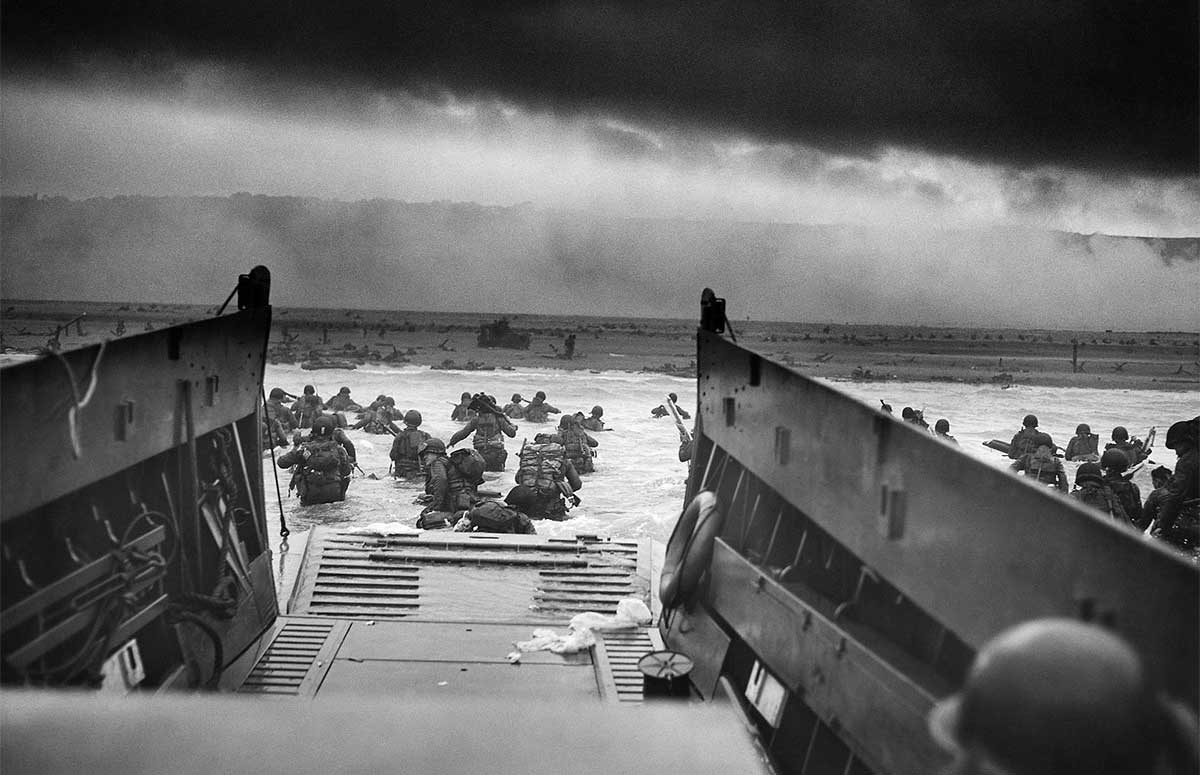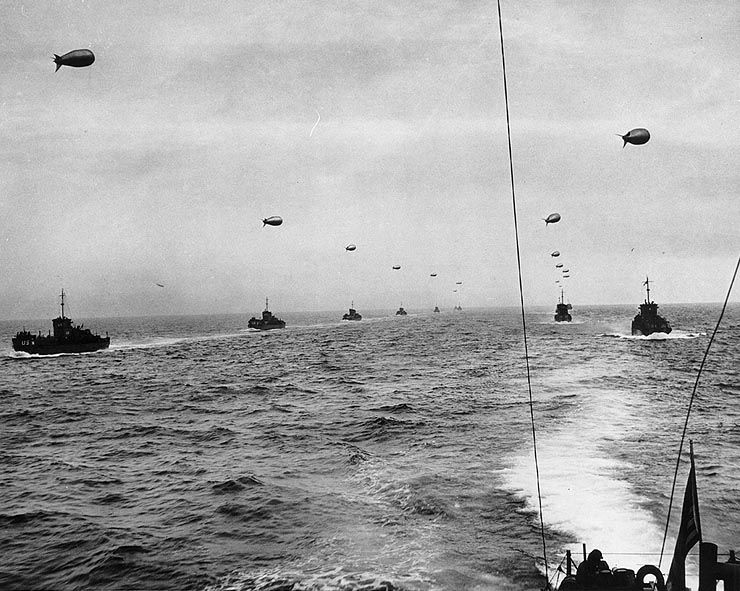D-Day Propaganda
Caroline Reed looks at the propaganda campaigns accompanying the D-Day landings on 6 June 1944.

Scant attention is given in the official histories of Operation Overlord to the massive propaganda operation which accompanied the initial D-day landings and then announced their success to occupied Europe. Specially equipped bombers carrying several million leaflets were the first Allied aircraft, except for airborne troop transporters, to fly over the Normandy beaches on June 6th, 1944. Within two days of the invasion, nine million leaflets had been dropped, bringing the news to friend and foe alike.
In their pre-planning for the D-Day leaflet drops Allied propagandists of the Supreme Headquarters of the Allied Expeditionary Force (SHAEF) Psychological Warfare Division could call on four years' gradually accumulated experience and expertise from the civilian and military personnel at their disposal. Radio broadcasts, too, had become a regular part of the propaganda effort culminating in the 'Voice of SHAEF', beamed into Europe from May 19th, 1944. The Royal Air Force had commenced leaflet raids over Germany on September 3rd, 1939, and the British Army's Psychological Warfare Branch had used the medium with some success against enemy forces in North Africa and Italy. From 1940, British squadrons had been engaged in dropping morale-boosting literature to the imprisoned peoples of Northern Europe and they were joined by the United States Army Air Force in 1942. By early 1944 a 'Special Leaflet Squadron', the American 422nd, was established and supplied with unarmed B-17's, camouflaged and modified for night flying. It was this unit which was to precede the Allied bomber force into France, ironically as daylight dawned on D-Day morning, dropping warning leaflets for the civilian population and special instructions for transport workers.
The warning leaflets appear, from several accounts, to have emerged as something of an afterthought to the initial invasion plans. Originally, it had been intended that an announcement of the Allied landings, in the form of a 'proclamation' from Eisenhower, would be dropped on the night of D-Day following their success. It was only after considerable pressure had been exerted by French representatives in London, through the British Premier, that SHAEF headquarters was persuaded of the necessity for prior leafleting of those areas which were to be the target for Allied air and naval bombardment. French statisticians and Churchill estimated that the 'softening up' process of bombing transport and communications centres and coastal areas in use by the Wehrmacht could cost some 80,000 civilian lives.
As Churchill emphasised in a letter to Eisenhower, written in early April 1944, 'post-war France must be our friend. It is not alone a question of humanitarianism, it is also a question of high state policy'. Eisenhower in his Crusade in Europe, first published in 1948, maintains that the predictions were unrealistic and that adequate plans for warnings by radio and other means were already well in hand before the French protests had been received. General Robert McClure, Chief of the Psychological Warfare Division, however, confided to his colleagues Frank Kaufman and Richard Crossman that it was only because the British Foreign Office had been 'getting hell from the French' that the original leafleting plan was changed. McClure was particularly concerned by the proposed new timing of the warning leaflet drop as maximum security required this to be a daylight operation, giving only some 30 minutes' notice of the coming bombardments. He feared that all 422nd Squadron's new, defenceless, black-painted bombers, intended to play a major role in the liberation campaign, would be lost without their protective cover of darkness. This was an opinion shared by many of their crews and it was with considerable tension that take-off was made after a 2am briefing on June 6th. Long hours later, after the first radio reports of the landings had been broadcast, the squadron returned to great scenes of jubilation, its mission accomplished without an enemy plane seen. As promised, the RAF and USAAF's pre-invasion assaults on the German Luftwaffe had paid dividends and secured the Allies an air superiority which benefited not only the leaflet squadron, but the whole invasion force.
The warning leaflet and the message for French and Belgian transport workers were dropped at dawn on June 6th and the French version of Eisenhower's 'proclamation', during the night of June 6th/7th. Suitably amended editions were dropped over Belgium and Holland on the same night and over Norway and Denmark on the night of June 10th/11th. The proclamation echoed the sentiments and tone of Eisenhower's radio speech to the people of Europe, pre-recorded several days before and broadcast by the 'Voice of SHAEF' on D-Day morning. Following the American Commander's speech came a series of addresses from exiled leaders of the nations of occupied Europe, and transcripts of these were later dropped in leaflet form.

France was not represented in this early broadcast despite urgent pleas that de Gaulle should participate. The General's impassioned address, is, however, also a broadcast transcript and has a rather chequered history. De Gaulle would not agree to pre-record a message to be relayed after Eisenhower's as part of the heads of state programme and kept British and American propagandists on tenterhooks as to whether he would make a broadcast on June 6th at all. Eisenhower in particular saw it as vital that this should happen and that de Gaulle should declare himself and the Free French to be wholeheartedly behind the Allied effort. Close and controlled co-operation with resistance forces and the civilian population in France was seen as essential to the liberation campaign and here de Gaulle's influence was felt to have some considerable bearing. In the event, his speech, pre-recorded at lunchtime, was put out at 6pm on June 6th and several million leaflets bearing its text were prepared for dissemination over France on the night of June 7th/8th.
De Gaulle's objections had been to references in Eisenhower's proclamation to the 'prompt and willing obedience to the orders that I shall issue', that he required from the French population and to the statement that 'as France is liberated from her oppressors, you yourselves will choose your representatives and the government under which you wish to live'. The French general found these elements in the proclamation insulting to the dignity of his fellow countrymen and to his own standing as their, he felt, chosen leader. Returning to London from Algiers on June 4th, he had been affronted by confusion which arose after Eisenhower handed him a typed 'draft' of the proclamation, apparently for his comment and amendment, while omitting to inform him that 47,000,000 copies in five languages had already been produced. Hence de Gaulle's refusal to give apparent approval to Eisenhower's stance by appearing on the air immediately after the SHAEF Commander had spoken.
It can be seen that problems arising from the propaganda planning for D-Day did little to sweeten British and American relations with the French in London, or at least with de Gaulle. After four years, however, Eisenhower felt able to afford a little reflection in tranquillity and, commenting on the efficacy of the warning leaflets in particular, he claims 'not only were the civilian casualties a mere fraction of those originally estimated, but the French nation as a whole calmly accepted their necessity and developed no antagonisms toward the Allied Forces as a result of them'.
Although it was leaflets designed for friendly civilians that caused the most controversy in London in the days before D-Day, it must be remembered that the main thrust of the propaganda campaign launched on June 6th was against the Wehrmacht. The objectives of this campaign had been discussed at length within PWD and were established in a Standing Directive for Psychological Warfare, issued in June 1944, but drafted in outline months before. The 'directive' describes the prime task of leaflet propaganda in the immediate invasion period as to stimulate defeatism in a Germany Army faced by the threat of encirclement in a two-front war and by the Allies' vast material superiority. When a beachhead had been secured, leaflets were to point to the 'weakness' of the Luftwaffe and the German Navy in their inability to forestall the invading armada. More basic propagandist themes were also given emphasis in the directive. German soldiers were to be encouraged to mistrust the foreign 'volunteers' fighting in their midst and to be given reassuring glimpses of the safe life that they could expect as Allied prisoners of war should they surrender.
The very first leaflets dropped over German troops on D-Day show some of this theory materialising in practice. On one a large map of encircled and bombarded Germany is accompanied by the announcement that she is fighting on four fronts: East, South, Home and now West. A second leaflet, addressed to reserve troops, contains a particular message for Polish units fighting with the Wehrmacht and tells both Poles and Germans that their comrades in the front line are being brutally used as 'human landmines' in a desperate attempt to defend the Normandy coastline.
Propagandist airborne 'newspapers' were widely used by the Allies on many fronts in the War and a special issue of the near daily Nachrichten fur die truppe, dropped over Northern Europe from April 1944, was produced on the evening of June 6th. This announced the breaching of the Atlantic Wall at several points to German troops in reserve areas. That the paper contained actual news of the morning's events demonstrates something of the efficiency of the leaflet production machinery established in Britain by 1944.